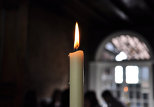Псково-Печерский мужской монастырь (Pskovo-Pechersky Monastery)
|
Печоры – самый западный город России без учёта Калининградской области. Расположен недалеко от границы с Эстонией. Год основания – 1472. Население – примерно 10 тыс. человек. Название «Печоры» происходит от старо-русского «печеры» (пещеры). Первое упоминание о пещерах и живших в них отшельниках, датируется 1392 го́дом. |
Pechory is the most western city of Russia without Kaliningrad Oblast taken in consideration. It is located near the Estonian border. Founded in 1472. Population of around 10 thousand people. The name “Pechory” originally comes from the ancient-rus “pechery”, or caves. The first mention of caves, and hermits living in them, dates back to 1392 years. |

|
|
|
В Печорах находится один из самых крупных и известных в России мужских монастырей, - Псково-Печерский. Основанный в 14 73 году, монастырь никогда не закрывался, даже в самые страшные времена Второй мировой войны. Расцвет Псково-Печорского монастыря в XVI веке связан с игуменом Корнилием, который возглавил монастырь в 27 лет. Его уважал сам Иван Грозный, который, правда, приказал казнить Корнилия, заподозрив того в измене. Потом, как обычно, раскаялся, и на своих руках перенёс тело Корнилия в монастырь. Монастырская дорожка, на которую капала кровь Корнилия, с тех пор зовётся «Кровавый путь» |
One of the largest and most famous male monasteries in Russia - Pskovo-Pechersky is located here in Pechory. Founded in 1473, the monastery has never been closed, even during the terrible tomes of WW II. The golden age of the Pskovo-Pechora monastery in the 16th century is associated with Abbot Cornelius, who headed the monastery at the age of 27. He was respected by Ivan the Terrible, who, however, ordered the execution of Cornelius, suspecting him of treason. Then, as usual, he repented, and he carried on his hands the body of Cornelius to the monastery. Since that time, the monastery path, on which Cornelius's blood dripped, is called the “Bloody Path”. |
|
Ivan the Terrible's repentance: he asks the hegumen (father superior) Cornelius to let him take the tonsure at his monastery. Painting by Klavdy Lebedev.
|
|
|
Во время Великой отечественной войны наместником монастыре был отец Павел, который помогал многим красноармейцам, больным и старым людям, а в монастырских пещерах укрывались советские разведчики. В Советское время монастырь был полностью отреставрирован, и сейчас каждый может любоваться его красотой и прикоснуться к истории нашей великой страны. |
During the Great Patriotic War, Father Pavel was the vicar of the monastery. He helped many Red Army soldiers, sick and old people, and Soviet intelligence officers were hiding in the monastery caves. In Soviet times, the monastery was completely restored, and now everyone can admire its beauty and touch the history of our great country. |








